Major Richard Lewis Hay Blake JENKINS
NSWMR and 20th Battalion, AIF
By Robert Simpson
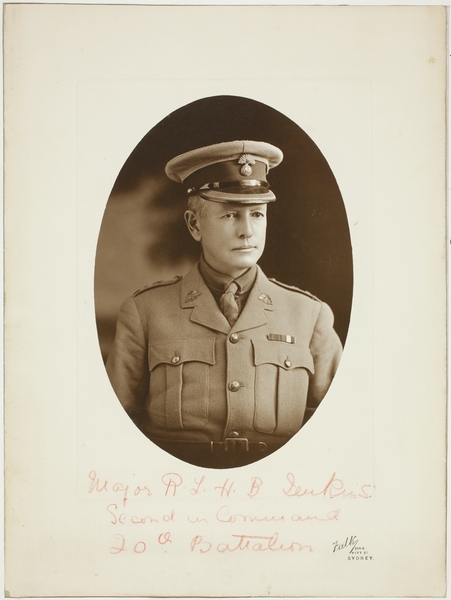
Image: State Library of New South Wales, PXA 1011/11. Inscription “Major R.L.H.B. Jenkins, R.A.A. – Gwen Dad- Killed in action. Dardanelles 11th Dec 1915 – Russell’s top Anzac – to be returned Mrs Jenkins, Belmont, Hornsby”
Richard Lewis Hay Blake Jenkins was born on 7 April 1866 in Nepean Towers, Douglas Park, New South Wales; a son of Richard Lewis Jenkins and Mary Rae Johnstone. He was one of nine children to them. Richard had been born in Newport, Wales on 15 January 1816. It is not sure when he moved to Sydney, but he moved there for health reasons. He was a qualified medical doctor. On 7 January 1852 in Sydney, he married Mary Rae Johnstone, a daughter of the first magistrate in the Hunter Valley. Mary had been born in Southampton, England on 16 August 1827. In 1858 Richard was elected to the New South Wales Legislative Assembly for Liverpool Plains and Gwydir and was defeated in the 1860 election. He was an early advocate for compulsory universal public education.
Doctor R L Jenkins and a son arrived in Sydney on the Lady Young from Brisbane on 19 February 1869. Again, he returned from Brisbane to Sydney, on the City of Brisbane on 27 December 1872. Richard passed away on 13 August 1883 in Brisbane and was buried in Rookwood Cemetery in Zone B, Section 1 Row 1. His denomination was recorded as Old Church of England. The grave inscription and details are recorded as ‘of Nepean Towers, N.S.W. b. 16 Jan 1816 (Central pedestal surmounted by draped urn. Grass surface. Iron rail surround. Also includes Vault Nos. 16-17 Row 2)’. Mary had been born in Southampton, England on 16 August 1827. She passed away on 14 April 1904 in Edgecliff, New South Wales and is buried in the same grave with a comment ‘wife of above’. His story is here – Richard Lewis Jenkins (freesettlerorfelon.com)
Their first child was George Henry Vaughan Jenkins, born on 24 November 1852 at Woolamon station, Namoi River, New South Wales. In 1892, a block of land he had purchased in Springmount under the alias of John Martin Heagney fulfilled conditions to issue a certificate. He appears in the 1891 England Census with his wife Beatrice Mary at her father’s house (Robert Charles Hubert, a J P Barrister) in Wrockwardine, Shropshire. He was 38 and she was 28 and George was living on his own means. They had five children. George appears in a list of non-renewal of annual leases for two portions of land in the Armidale district in 1890, so the land became Crown Land. In 1895 a part of land he owned along the road from Armidale to Loch Abra was claimed by the Government to make a road, with an entry in the Gazette stating he could apply for compensation. George passed away in 1910 in Armidale. His estate was recorded in a newspaper article, which noted he was a grazier of Herbert Park Station near Armidale and it was valued at £51859. The story of the station and George is here – https://www.nswera.net.au/biogs/UNE0208b.htm
Edward Johnstone Jenkins was born on 24 October 1854 in Picton, New South Wales and was baptised on 24 November of the same year in the District of Liverpool Plains. In the 1930 and 1933 electoral rolls he was living at 35 New South Head Road, Vaucluse with other family members and was a Physician. He passed away on 2 September 1940 in Woollahra, New South Wales.
Emily Ellen Vaughan Jenkins was born on 14 June 1856 in Picton, New South Wales. She married George M Simpson in 1875 in Picton. In 1926 she embarked on Sophocles in Melbourne in 1st Class, with a daughter Sybil, disembarking at Southampton on 26 May 1926. She was listed as a Grazier. On 3 September 1927 they embarked on Orvieto, returning to Sydney, Australia. In the 1930 electoral roll she was listed at Stonehenge, Glen Innes with two daughters and all three were listed as doing home duties. She passed away on 15 October 1930 in Glen Innes, New South Wales.
Elizabeth Lloyd Jenkins was born on 24 Dec 1857 in Richmond Terrace and was baptised on 9 Mar 1858 in St Mary, Denham Court, Cumberland, New South Wales. She married Richard Manning Firmin, from London, a labourer, on 28 April 1886 in St Peters Church, Cooks River Road. On 22 March 1879 she married William Augustus Concannon, but he died in 1885 in Queensland. They had three children, one of whom was George Lewis Blake Concannon, born on 4 February 1881 in Brisbane and killed on 27 April 1915 at Gallipoli as a Captain with the 2nd Battalion AIF. His story is here – https://tgsoba.twgs.qld.edu.au/record/concanon-george-lewis-blake/ . Elizabeth then remarried, to Stanley Bruce Kennard in 1889 in Woollahra, New South Wales. She passed away in Steyning, Sussex, United Kingdom in late 1908 and was buried at Marnhull, Dorset.
Mary Rae Johnstone Jenkins was born on 20 October 1859 in Sydney. She married Henry Ralfe (born 1853) on 18 November 1882 in New South Wales. He died in 1895 in Waverley. A son of theirs was killed in WW1, Captain Henry Douglas Eyre Ralfe (1890-1918). His grave and story is here – https://www.findagrave.com/memorial/56434291/henry-douglas_eyre-ralfe . She then married Charles George Holmes A’Court (he had been married three times previously and all his wives had passed) on 26 June 1901 in Sydney. They lived in Brisbane for a while, before returning to England where he passed away in 1924. Mary passed away in Sturminster, Dorset, England on 28 December 1945 and is buried in St Peter and St Paul Church Heytesbury, Wiltshire with her husband.
Grace Llewellyn Vaughan Jenkins was born on 29 August 1861 at ‘Nepean Towers’, Picton, New South Wales. She married Thomas Charles Fenton in 1885 in Picton NSW. He was ranked fifteenth in order of merit of thirty-six candidates accepted as first-class Naval Cadets following the entrance examinations of December, 1864 and was promoted to the rank of Lieutenant on 15 October 1875. They moved to England. Thomas was Captain on HMS Boomerang from February 1891 to May 1894, then HMS Rattlesnake from July 1894 to September 1894. He was placed on the Retired List on account of age with the rank of Commander on 9 March 1896. In the 1911 census he was listed as a retired Commander in the Royal Navy. He passed away in 1931 in Hampshire and Grace had passed away in 1927. Their daughter, Mary Grace Sybil Omerod Fenton (Born in 1893 in NSW) had previously passed in 1925.
Sybil Maud Mary Jenkins was born on 14 May 1863 at ‘Nepean Towers’, Picton, New South Wales. She married John Hubert Plunkett Murray in 1889 in Sydney. Sybil passed away in 1929 in Ryde NSW. John’s story is here – https://adb.anu.edu.au/biography/murray-sir-john-hubert-plunkett-7711
Richard Lewis Jenkins was born on 23 November 1864 and died on 26 November 1864 at ‘Nepean Towers’, Picton, New South Wales.
Their last child, Sydney Vaughan Jenkins was born on 8 November 1868 but passed away on 16 February 1869 at Nepean Towers, Picton, New South Wales.
Richard was baptised at St Peters Anglican Church in Sydney on 7 February 1867 by G H Moreton. His father was listed as a Gentleman. He was educated at King’s School, Parramatta and Sydney Grammar School. The New South Wales Government Gazette has an entry for Richard from the ‘Colonial Secretary’s Office, Sydney, 19th August 1899. His Excellency the Governor, with the advice of the Executive Council, has been pleased to make the following appointments in the Volunteer Force, viz.:- MR. RICHARD LEWIS HAY BLAKE JENKINS to be First Lieutenant … in the 5th Regiment Reserve Scottish Rifles’.
He married Blanche Elizabeth Brown, of Belmont, Hornsby, New South Wales on 29 November 1893 in Waratah, New South Wales. The Sydney Morning Herald of Saturday 23 December 1893 had an entry under Marriages for ‘JENKINS – BROWN. – November 29, at St. Philip’s Church, Waratah, by the Rev. Archibald Shaw, assisted by the Rev. Sydney Grime, R. L. H. B. Jenkins, Lieutenant N.S.W. Artillery, youngest son of the late Mr. R. L. Jenkins, to Blanche, youngest daughter of the late Mr. George Brown, of Waratah, Newcastle.’ They had three children, Godfrey Blake Jenkins, Emily Mary Gwendolen Jenkins and Evan Stuart Jenkins.
Godfrey was born on 28 September 1894 at Woollahra, New South Wales. In 1911-12 he received the Senior Cadets’ District Competition Medal. He served in WW1, embarking on HMAT Berrima A35 on 19 August 1914 in Sydney as 896 Private with Naval and Military Expeditionary Force (Tropical Unit) (1st Battalion). He was a single 20-year-old orchardist with his next of kin his mother. He had previous service with Garrison Artillery, 26 AMC and 19 Infantry. His description was 20 years and 1 month old, height 5 foot 5 inches, weight 8 stone 6 pounds, chest measurement of 35 inches and a dark complexion with brown eyes and dark hair. Church of England was his religious denomination and he had a leaf shaped birth mark on his left arm. They embarked for active service on 19 August. He was promoted to Lance Corporal on 27 August 1914 and was discharged with time expired on 18 January 1915. He then enlisted as Private 12 in the AIF on 25 February 1915 with 20th Battalion. His description had changed a bit, with height 5 foot 3 ½ inches, weight 114 pounds, chest 30 to 33 inches and a dark complexion with blue eyes and brown hair. He embarked with the 20th Battalion D Company 5th Infantry Brigade on HMAT Berrima A35 at Sydney on 26 June 1915. His description in the nominal roll was a single 21-year-old of independent means, with his next of kin his mother Blanche Jenkins, both of Belmont, Hornsby NSW. His religion was Church of England and he was paid 5 shillings a day. On 16 August 1915 he embarked to go to Gallipoli, serving under his father. Promoted to Lance Corporal in October then Temporary Corporal on 25 November 1915 on Gallipoli.
He was promoted to 2nd Lieutenant on 1 March 1916 and went to France that month. A letter was sent to his mother on 15 August 1916 stating he was ‘now in the Duchess of Westminster 1st Red Cross Hosp, 30/7/16, suffering from gas poisoning, mild.’ In 1916 he had some service with the 22nd Battalion and in 1917 he was with the 63rd Battalion for a few months. He was promoted to Lieutenant 28 October 1916. Godfrey was placed on the Regimental Seconded List (Invalided) on 11 June 1918.
He returned to Australia at his own expense on 10 January 1919 with 1914 leave and his appointment was terminated on 29 April 1919. His medals included the 1914/15 Star, British War and Victory Medals. The Colonial Auxiliary Forces Long Service Medal and Colonial Auxiliary Forces Volunteer Decoration were also issued to him.
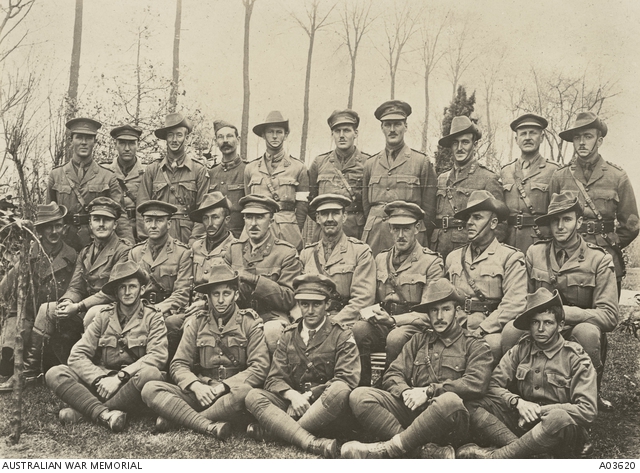
Group portrait of officers of the 20th Battalion. Left to right, Back row: Lieutenant (Lt) (later Captain ) John Allan Broadbent MC; Captain (Capt) Keith Stewart Cresswell Single, Padre; Lt Leslie Byrne MC (killed in action 18 September 1918); French Interpreter; Capt (later Major) Eric Lloyd Hutchinson DSO, Regimental Medical Officer; Lt (later Captain) Robert Rainy Harper DSO; Lt (later Captain) Harold Bourchier Dight Barlow MC; Lt (later Captain) Norman George Blanchard; Lt John Robert Porteous (killed in action 23 May 1916); Capt Horace Roy Rush (killed in action 15 November 1916): Second row: Lt J W O’Connor; Capt Stanley Roy Kent MC; Capt Albert James Roper; Major (Maj) (later Lieutenant Colonel) Harold Paul; Maj Richard Francis Fitzgerald DSO; Lieutenant Colonel (LtCol) John Lamrock VD CB, Commanding Officer; Capt (later Major) Charles Holmes Howard OBE, Adjutant; Maj Mauder Ross; Lt (later Captain) Arthur Gardere Ferguson (killed in action 14 June 1916); Front row: Lt (later Captain) Arnold Stratfall Evans; Capt Arnold Kingsley Hocking MC (killed in action 20 September 1917); Lt (later Captain) John Malcolm Moore; Lt (later Major) John James Lawton McCall DSO; Lt Godfrey Blake Jenkins. AWM A03620
In 1918 he married Dorothea Logan Johnson in Lanarkshire Scotland. Dorothea had been born in Barr Head Kilmarnock, Scotland on 13 March 1900. They had four children; Robert Lewis Blake Jenkins (1923-2017), David Rae Jenkins (1925-2011), Phillipa Vaughn Jenkins (1928-2016) and Michael Godfrey Jenkins (1931-1990).
After the war he was appointed to 2/18 Battalion on 1 October 1920, 18th Battalion (new organization) on 31 March 1921 and was provisionally transferred to AGA on 17 October 1922, with the transfer confirmed on 11 April 1923. Godfrey was promoted to Major on 1 January 1929 and appointed SO for 1st Heavy Brigade on 1 October 1929, relinquishing the position on 30 September 1935 and was transferred to the unattached list the next day. Godfrey served for many years in the Militia. On 1 October 1920 Godfrey was promoted to Lieutenant, Captain on 17 October 1922 and Major on 1 January 1929. He did some exams to become a Lieutenant-Colonel in 1930 and 1931, but on both times did not pass, with the comment ‘We are of opinion that he has not attained the necessary standard.’ Godfrey attested with the Australian Military Force on 20 August 1941 at Paddington, while living in Killara and was given the service number N76334. He enlisted for service at the Recruiting Depot E.C. Godfrey stated he was a managing secretary and for previous military service he listed AMF as a Major in 11th Brigade RAA (M), and for other military service as a Lieutenant with 20th Battalion AIF and then Major with RMPO Area 30. His wife and next of kin, Dorothy, was living with him at 88 Springdale Road Killara NSW. Their house – https://www.realestate.com.au/property/88-springdale-rd-east-killara-nsw-2071 . Godfrey served as Major N278217, as recorded on his Mobilization Attestation Form, with the Area Recruiting Staff on continuous Full Time War Service with the CMF from 27 November 1941 to 11 June 1944, only in Australia. His service ceased on that date in Sydney as 1st Brigade Area Officer, Area 33-c. Medals were issued for his service, the 1939-45 War Medal and Australian Service Medal. In the 1963 electoral roll Dorothea was living at 11 Yarrabung Road St Ives, doing home duties, with Godfrey Blake, Michael Godfrey (both with no occupation) and Philippa Vaughan (a staging records clerk). Godfrey passed away on 25 October 1966 at Killara, Bradfield, New South Wales, with a newspaper report stating he was ‘Late of St Ives and Killara’.
Robert served in WW2 as NX36850, enlisting in New South Wales. He had changed his birth year to 1922. Previously he served in the Permanent Army 1st Heavy Brigade RAA, as Gunner 9734 from February 1941, and transferred to the AIF on 18 June 1941. Robert was at Darwin and was then sent to Timor. In February 1942 he was reported missing, later reported to be a POW, being captured at Aircom on 23 February 1942 as part of 2/1 Heavy Battery. His description was 5-foot 7½ inches tall, weight 128 pounds, was of fair complexion with blue eyes and light brown hair. His religion was Church of England. Robert was previously a jackeroo and his father of 88 Springvale Street Killara was his next of kin. He was discharged on 12 December 1945. Robert was entitled to the 1939/45 Star, Pacific Star, 1939-45 War Medal, Australian Service Medal 1939/45, Australian Service Medal 1945/75 with clasp SW Pacific and Returned from Active Service Badge. In the 1949 electoral roll he was a jackeroo at Nelyambo station. From the 1958 to 1968 rolls, he was a working manager at Bowylie. In the 1972 to 1980 rolls he was in the ACT at 23 Andamooka St, Fisher. He married Elizabeth Anne Gill (1931-2009) and they had Tim and Wendy. David also served in WW2 as Private NX206774. He was also a jackeroo and enlisted on 23 April 1945. In March 1946 he was sent to Rabaul and served with the 31/51st Infantry Battalion before being transferred to the 26th Battalion in May. Returning to Sydney in July 1946, and after being trouble when he neglected to obey Military orders, he was discharged on 22 January 1947. David was entitled to 1939-45 War Medal, Australian Service Medal 1939-45 and Australian Service Medal 1945-75 with clasp PNG. Phillipa went to England in 1955 and returned in 1957. She was a receptionist/typist. In the 1968 electoral roll, Michael was living at Acron Street Bradfield and was a TV propsman. By the 1972 roll he was a caretaker at the Bowling Club Killeaton Street West, St Ives and in 1980 he had retired and was living at 15 Coventry Street, Kalgoorlie.
Emily was born in 1898 in Paddington. In 1926 she left from Sydney on the Moldavia, arriving in London on 4 June. The 1930 electoral roll has her living at Belmont, Peat’s Ferry Road Hornsby. She passed away on 6 December 1943 in Hornsby, New South Wales as a spinster with probate granted on 4 September 1944.
Evan was born on 7 August 1906. In the 1928 electoral roll he was living at the Officer’s Mess, Maytone Queensland and was ‘officer staff corps.’ In the 1930 and 1931 rolls he was living at George’s Heights, Mossman and was an officer. On 1 September 1934 he arrived at Adelaide on Maloja in 1st Class from Bombay, India. He was an Army Officer, age 28 and intended to return to India. On 2 January 1952 he boarded Himalaha at Southampton, bound for Sydney. He was in 1st Class, age 45, retired and intended to live in Australia. In the 1954 electoral roll he was living at 241 Pacific Highway, Hornsby and had no occupation. Evan passed away in early 1977 in Yeovil, Somerset, England. Probate was granted in Winchester on 3 June and showed he lived at Broke Gate Cottage, Bishops Down Sherborne Dorset and stated he died on 4 March 1977 and was valued at over £17000.
In 1880, at the age of 14, Richard enrolled at Sydney Grammar School. An entry in a register for The King’s School reads ‘Jenkins Richard Lewis Hay Blake 1444 (1879-83) 7 Apr 1866 Richard Lewis Jenkins Medical Practitioner Berrima 1852 M Mary Rae Johnstone; School Cdt. Medical Practitioner and Army Officer. 11 Dec 1915. M 1893 Blanche E. Brown.’
He commanded Fort Scratchley at Newcastle in 1895 and 1896.
Richard served as a Special Services Officer in the South African (Boer) War, with the RAA. He embarked at Sydney on transport Moravian on 17 January 1900. They arrived at Cape Town on 17 February 1900 and were ordered to Orange River Colony on 27 February. He took charge of a machine gun section of Royal Garrison Artillery at Fort Munster. Then he commanded a detachment of Royal Garrison Artillery with two 9 pounder guns at Zuit Pan Drift. After being admitted to hospital suffering dysentery on 20 March, he returned to duty 12 April, taking command of mounted infantry details at Fort Munster. Richard was appointed staff-officer and Provost Marshal on 19 May. He returned to Australia, invalided, on 17 August 1900. Captain Jenkins subsequently commanded a machine gun section in the 2nd (New South Wales) Mounted Rifles Regiment. They left Sydney on 15 March 1901 and arrived at Port Elizabeth on 16 April 1901. They left Cape Town on 4 May 1902, arriving at Albany WA on 21 May, Melbourne on 29 May, and disembarked at Sydney on 4 June 1902. (From Murray page 106). He engaged in operations against Generals De La Rey, Kemp, Potgeitiers, and Vermaas: (a) Served in the Western Transvaal under command of Major General Fetherstonhaugh from 23 April to 1 October. Principal operations: Capture of Potgeitier’s convoy on the Vaal, 24 May 1901; capture by the regiment of General De La Rey’s convoy of 106 wagons, a large quantity of cattle, ammunition etc. (b) Served in the Eastern Transvaal, under command of Major General Fetherstonhaugh; engaged in many night marches, resulting in the capture of more than a thousand prisoners.
He was awarded the Queen’s South Africa Medal with three clasps (Cape Colony, Orange Free State and Transvaal) as a Captain with the 2nd Regiment NSW Mounted Rifles. In the remarks column the medal roll has ‘1st Co. W.D.R.C.A. 1900’. In a list of Officers of New South Wales Military Contingents serving in the Boer War from 1899 to 1900, he is recorded as Lieutenant R L H B Jenkins of NSW Royal Australian Artillery, serving as a Special Service Officer from Sydney District. He was also awarded the King’s South Africa Medal with two clasps (South Africa 1901 and South Africa 1902) as a Captain. The medal roll records he had previous service in South Africa with NSW Special Service in February 1900. (Murray page 199 and medal records).
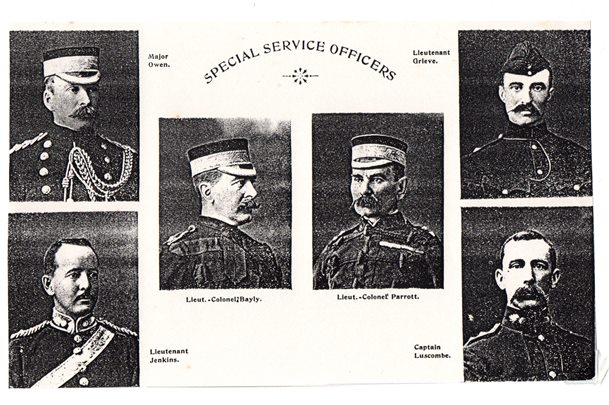
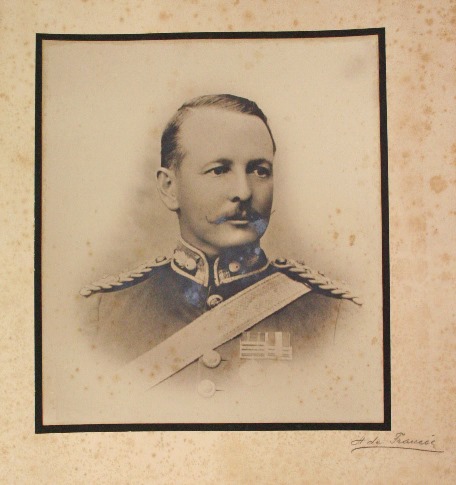
In filling out his application for a Commission in the 20th Battalion 5th Brigade AIF, Richard listed his Educational Qualifications as The Sydney Grammar School, The Kings School, School of Instruction Wellington Barracks London and schools of instruction in New South Wales. His Military Qualifications were The Kings School Cadets, 4th Battalion Royal Manchester Regiment England, Sydney Scottish Rifle Volunteers, Sydney Light Horse, 4th Battalion Royal Manchester Regiment England (listed twice on the form), Royal Australian Artillery Regiment and South African War 1900-02. Twenty-seven years in all. Richard qualified at a competitive exam for appointment as a 2nd Lieutenant in 1886 with the 4th Battalion Royal Manchester Regiment in England. His current civilian employment was a farmer and orchardist. He was a married British subject with his next of kin and postal address the same as recorded on the nominal roll. The form was signed and dated on 18 May 1915. A medical examination showed he was 5-foot 6½ inches tall, weighed 10 stone 3 pounds, had a chest measurement of 36½ inches and had good eyesight. He was recommended to be a Major in the 20th Battalion Headquarters on 24 June by the Commanding Officer and on 8 July by the District Commandant.
Richard was appointed to the AIF on 12 April 1915 as Second in Command of the 20th Battalion. His record shows that Major Richard Lewis Hay Blake Jenkins, late R.A. Artillery was recorded in the Australian Gazette No 32 on 24 April 1915. He had 23 years’ service including Militia in England, Cadets Militia and Regulars in New South Wales. His civil occupation as listed as ‘Retired Officer R.A. Artillery Farming and Dairying etc.’ He was married with his next of kin recorded as ‘Wife B. E. Jenkins c/o J. C. Bragg 76 Pitt Street Sydney, N.S.Wales.’
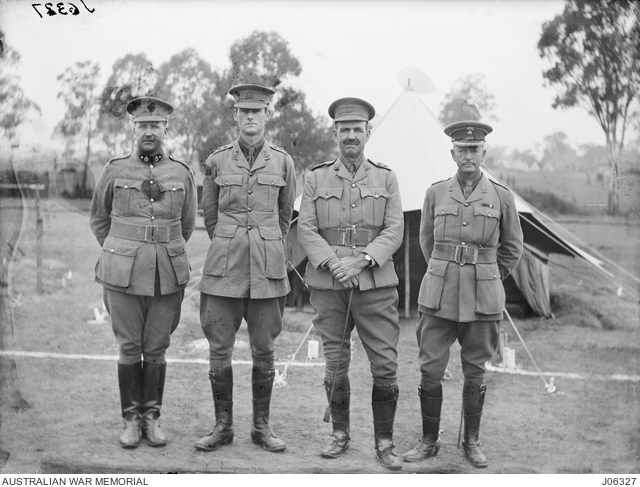
Group portrait of officers of the 20th Battalion at Liverpool Camp, shortly before they embarked for Egypt on 25 June 1915 aboard the HMAT Berrima. Identified left to right: 598 Quartermaster Sergeant Stanley Roy Kent, (later awarded the MC as Captain (Capt) Kent); Capt Eric Lloyd Hutchinson, (later awarded a DSO); Brigadier General John Lamrock, VD (later warded a CB); Major Richard Lewis Hay Blake Jenkins, served in the Boer War, (later killed in action at Lone Pine on 11 Dec 1915; he is remembered with honour on the Lone Pine Memorial in the Anzac cemetery, Gallipoli, Turkey). AWM JO6327
From the Nominal Roll, Major Richard Hay Blake Jenkins embarked on transport HMAT Berrima A35 at Sydney on 25 June 1915 with Headquarters of the 20th Infantry Battalion, as Second in Command; part of the 5th Infantry Brigade. He was a 49-year-old farmer, married with and address of Care of J.C. Bragg, 76 Pitt Street, Sydney, NSW / Belmont, Hornsby, NSW. His wife, Mrs B E Jenkins, was next of kin and her address was recorded as the same. His religion was Church of England and he had been serving with the 41st Infantry AMF when he enrolled in the AIF. His rate of pay was 30 shillings daily, with 15 shillings as an allotment to Australia, nett pay of 10 shillings and 5 shillings deferred. They arrived in Egypt on 24 July. After training there, they embarked on S.S. Saturnia at Alexandria on 15 August, and sailed the next day. Richard was listed as Commanding Officer. After arriving at Mudros on 19 August, they transferred to Osmanieh on 21 August and travelled to Anzac, landing there that night. The Museum has a transcript of a manuscript for the 20th Battalion which gives a detailed account of what they did on Gallipoli.
He was sick on 7 September 1915 at Gallipoli, and was sent to hospital with dysentery. That day he was transferred to Mudros to the 13th CCS and admitted to HS Maheno which sailed to Malta. A manuscript at the Australian War Memorial, listed as ‘AWM224 MSS148 – [Unit manuscript histories:] 20th Australian Infantry Battalion: Narrative by Capt V B Portman. Gallipoli, Passchendaele, Somme, 1918.’ records an entry on 12 September which includes ‘On the evening of the 13th Major R.L.H.B.Jenkins was evacuated, having become seriously ill’. (As he was writing it in 1919, he may have got the date wrong.) Disembarking there on 12 September (recorded in his service record as sick, slight), he was transferred to HS Brasile for England on 8 October. On 10 October he was admitted to the 3rd London General Hospital in England. He embarked on HT Andania on 5 November at Devonport and was due at Mudros on 14 November. Richard then returned to Gallipoli to his unit on 6 December. Another entry in the manuscript reads on 6 November ‘It was during the month spent in Monash Gully that Lieut-Colonel J. Lamrock, and Major R.L. Jenkins re-joined the Battalion, but the dates I am not sure of.’ He also records on 5 December ‘I think it was on the 5th or 6th that Major R.L.H.B. Jenkins returned to the Battalion.’ The manuscript continues on, during 9 December ‘at 7.4. p.m. in the shape of a violent bombardment. Lone Pine was again badly damaged. It was now well-known that an evacuation was contemplated, and the definite orders were issued on the 9th, Col. Lamrock taking command of the Brigade, and Major Jenkins assuming command of the Battalion. It was decided that the 20th Battalion should evacuate Russell Top. December 11th and the Battalion received orders to take over the position again. The worst misfortune that befell the Battalion in its early history now overtook us. Majors Jenkins, Marcus and Uther, were killed by a shell when proceeding to reconnoitre the position. This was at 4 p.m. Where the sap ran up out of Monash Gully on to the ridge above, it was very shallow, and for some yards men passing there were head and shoulders out of it. The party stopped in this shallow section to look over the Turk positions – from there almost out of rifle range – and during that time one of the guns must have been trained on them, for they had hardly moved when a shrapnel shell burst against them killing Major Jenkins and Marcus immediately, and mortally wounding Major Uther who shortly after succumbed. This was a stunning blow to the Battalion, and cast a gloom over us that lasted for a very long time. Each of these Officers was greatly esteemed and personally admired in the Battalion – perhaps more so than any Officer has since been privileged to be. They were buried with all honour in the new cemetery at the seaward end of Monash Gully. In later years many thoughts will drift back to that Cemetery and many of us will envy them their graves when our times draws near. We could spend no time in melancholy reflections, however, and the relief took place as planned on the morning of’ the next day. Richard was killed in action 11 December 1915. He was buried on 12 December 1915 at the cemetery at the foot of Walker’s Ridge at Gallipoli.
Base Records sent a letter to his wife that Richard has disembarked at Malta from Hospital Ship Maheno on 12 September slightly sick. On 19 October 1915 a Medical Board for Major Jenkins 20th Battalion AIF, age 49½ years with 23-years’ service, had been suffering from dysentery, but ‘since he was last boarded he has had no symptoms of Dysentery and has now recovered.’ The disability was caused and contracted while he was in service, he had no control over it and it was caused by exposure to infection. Leave was granted from 12 October. Base Records sent a note to Blanche regarding a wire they had sent on 30 September, on 13 October, advising her that he had embarked on HS Brasile on 2 October. They replied to another letter from Blanche on 28 October, saying that he was ‘now in the Hospital at London, suffering from “Dysentery” and stated his address for correspondence. A letter had been sent to Blanche on 11 November 1915 from Base Records advising her that he had returned to Egypt for duty.
The war diary of the 20th Battalion recorded that at Fatigue Gully on 11 December 1915 ‘Cap. Single from hospital, 5 evacuated sick. Instructions received to take over Russels Top. Maj’s Jenkins, Harcus and Uther killed at the junction of Rest and Monash saps while on the way to take over Russels Top.’ The journal of 164 Private John Booth of A Company 20th Battalion noted ‘On Dec/11/15 three of our majors, Jenkins, Harcus and Uther, were killed by shrapnel whilst going through the sap to Russels Top. It appears that the Turks were firing their 74s at our battery at the back of Walkers Ridge and generally fired three times in succession and a shell fell short and got them. It was a severe loss to the battalion as these officers were very popular and the best we had.’
Richard is commemorated on the Lone Pine Memorial; his grave of Walker’s Ridge having been lost. His name is recorded on Panel 64 of the memorial. Richard Lewis Hay Blake Jenkins’s name is located at panel 91 in the Commemorative Area at the Australian War Memorial.
The Governor General and MC2 were notified that he had been killed in action on 10 January 1916 and a copy was made for War Pensions on 12 January.
The Field Service form for a report on the death of an officer was filled out by the Commanding Officer of the 20th Battalion AIF and shows that Major RHLB Jenkins of 20th Battalion 5th Brigade AIF was killed in action on 11 December 1915 on Gallipoli. His burial report or pay book were both not yet at hand, as signed by Major C Griffiths at Alexandria on 26 January 1916.
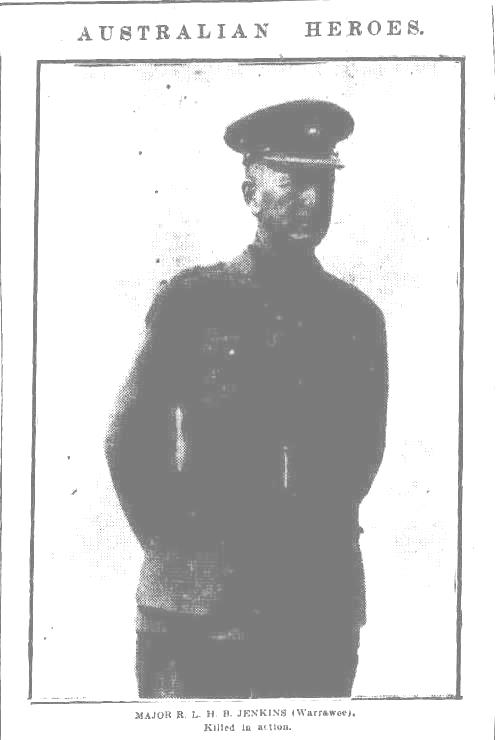
His photo in the Sydney Morning Herald of 29 January 1916 on page 10.
‘On Dec/11/15 three of our majors, Jenkins, Harcus and Uther, were killed by shrapnel whilst going through the sap to Russells Top. It appears that the Turks were firing their 75s at our battery at the back of Walkers Ridge and generally fired three times in succession and a shell fell short and got them. It was a severe loss to the battalion as these officers were very popular and the best we had.’ (Journal, Pte John Booth, No.164, A Coy. 20th Battalion).
‘Poor Uther met his end on the 13th November. He was a wonderful chap, a keen, lovable soldier. He was with two other good soldiers – Majors Jenkins and Harcus. It happened that when it was decided to evacuate Anzac, the new Brigade was ordered to go back to Mudros, and the 20th were instructed to take over on the night of 13th November, and on the morning of that date the Headquarters staff (Major R.C.H. Jenkins, A./C.O., Major R.F. Fitzgerald A./2nd-in-Command; Captain C.H. Howard, Adjutant; and the two senior Company Commanders, Majors J.L. Harcus and G.A. Uther) started to go to Russell [sic] Top to go over the details. When proceeding up Monash Gully sap, a couple of shells were fired at the party from a ’75’ at Olive Grove, but, as the trench was deep, no harm was done. When the party reached the top, the sentry there said the gun was shelling the wide sap heavily, and a halt was called. After a wait of a few minutes the party set off again, and had barely gone a dozen yards when a shell burst right among it, killing Uther, Jenkins, and Harcus, and only knocking down Fitzgerald and Howard.’ (Brigadier General John Lamrock, 20th Bn. ‘Surprised: But the Turks Were There.’ Reveille Vol.3 No.7 31 March 1930 page 57).
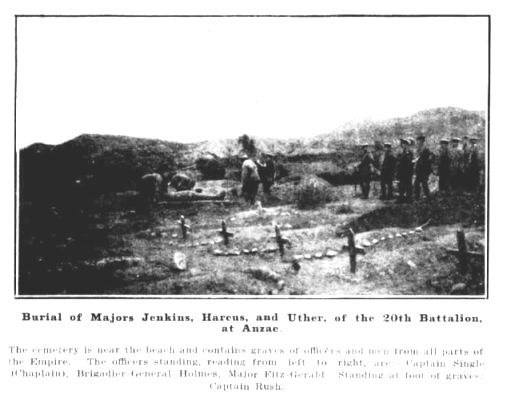
A photo of the burial of Majors Jenkins, Harcus and Uther, of the 20th Battalion, at Anzac, published in the Sydney Town & Country Journal of 29 March 1916 on page 32 is captioned: ‘The cemetery is near the beach and contains the graves of officers and men from all posts of the Empire. The officers standing, from left to right, are: – Captain Single (Chaplain), Brigadier General Holmes, Major Fitzgerald. Standing at the foot of graves – Captain Rush.’ The graves have been lost and he is now commemorated at the Lone Pine Memorial.
A note shows that Major Richard Lewis Hay Blake Jenkins, 20th Battalion AIF was killed in action at Gallipoli on 11 December 1915. This was recorded by cables number MFC 34248 and MFC 34672 from the Officer Commanding the Intermediate Base at Alexandria, dated 6 and 10 January 1915, and was confirmed by Army Form B 104-52.
Leisuis, Black & Way Solicitors wrote to Base Records on 27 January 1916 asking for a certificate of death for Richard, stating his full name and other military details. They also added, that due to it being a considerable estate, and could not be dealt with until Probate was granted, that could they expedite the certificate. On 3 February 1916 Base Records replied that the ‘official confirming documents covering report of death of Major R. H. L. B. Jenkins, 20th Battalion, have not yet been received by this department’ and they would forward the details when received. Base Records sent them the ‘certificate of report of death’ on 3 March 1916.
The National Mutual Life Association wrote to Base Records on 28 January 1916 stating ‘that Richard Lewis Hay Blake Jenkins assured with this Association was killed whilst on Active Service with the Australian Imperial Forces in the Dardanelles on or about the 11th December 1915. I shall be glad if you will kindly let me have the following information for identification purposes.’ They listed place of birth, age, height, complexion, colour of eyes and hair, any distinguishing marks and next of kin. On 3 February 1916 Base Records replied to them with a note and an enclosed list of identification particulars for Richard.
On 7 March 1916 the solicitors replied to Base Records, thanking them for the letter they sent including the ‘Certificate of Report of Death’.
The Times of 21 March 1916 recorded ‘MAJOR R. L. H. B. JENKINS, 20th Australian Infantry, who was killed on December 11 at Anzac, was the youngest son of the late R. L. Jenkins, of Nepean Towers, N.S.W., Australia, and of the late R. L Jenkins, of Nepean Towers, N.S.W., Australia, and of the late Mrs. R. L. Jenkins, of Orielton, Sydney, his mother being a daughter of the late Major Edward Johnstone, 50th Regiment, who settled in N.S.W. after the New Zealand War, having previously served in the Peninsular and Waterloo Campaigns, and who had 10 great-grandsons serving in this war. Major Jenkins served for many years in the Permanent Artillery and was A.D.C. to General Hutton when in command of the Australian Defence Forces. He served through the South African War gaining two medals, and retired from the Royal Australian Artillery some years later. He volunteered at once on the outbreak of the present war and was appointed to the 20th Battalion, 5th Brigade, which he commanded at Anzac when he was killed as he was proceeding up a sap to the front trenches at Russels Top in company with two other field officers. His adjutant writes:- “His death was a severe blow to the battalion, which held him in much esteem.” Major Jenkins leaves a widow and three children, the eldest of whom, Godfrey, volunteered at once for the expedition to seize Samoa and German New Guinea, being promoted to Corporal. He then joined the 20th Btn. as a private, and was present when his father was killed. He has now received a commission.’
In his service record is a slip for a pension claim for his daughter Emily Mary Jenkins of “Belmont” Peats Ferry Road Hornsby which was withdrawn. Another form for his son, Evan B Jenkins showed a pension of £13 per annum was amended to £1 per fortnight, from 12 March 1916. His wife, of the same address above, was granted a pension of £116 per annum from the same date and their child Evan Stuart Jenkins was also granted a pension of £13 from the same date, with his mother as trustee.
Blanche wrote to Base Records on 6 April 1916 advising them that the address they had for correspondence was an office address and, as she had received a letter from the Camp Quartermaster at Zeitoun that the effects of her husband were being sent, she asked that the effects be delivered to their private address of ‘Belmont Hornsby N.S.Wales’. Base Records sent an acknowledgement to her on 13 April 1916, stating it had been recorded on his records.
The Sun of Sydney on Wednesday 19 April 1916 in page 9 under ‘WILLS’ a notice: ‘The will of the late Major Lewis Hay Blake Jenkins, of Peat’s Ferry-road, Hornsby, killed at Gallipoli whilst attached to the 20th Battalion, A.I.F., on December 11 last, has, for probate purposes, been proved at £13,729. Testator appointed Joseph Charles Bragg and Lillian O’Grady executors and trustees. Subject to a bequest of £1000 to Lillian O’Grady in recognition of the manner in which she managed his affairs at Niagara Park, Narara (N.S.W.), he bequeathed the estate to his widow and children.’
On 9 May 1916, the Deputy Federal Commissioner of Land Tax wrote to Base Records asking if they could verify he died on active service and required details. Their reply on 15 May it was confirmed he had been killed in action on Gallipoli and also noted this ‘Officer is recorded as born on 7th April 1866, a farmer and orchardist by occupation, next-of-kin being shown as’ his wife. A receipt acknowledging the letter being sent to them was sent back to Base Records on 22 May 1916. A tin trunk and kit bag of Major Jenkins were delivered to Blanche by Thomas Cook from Egypt on Demosthenes. She dated the form on 15 May 1916. The lists from the various items returned to Blanche are below. (With thanks to NAA).
In the Index to Deceased Estate Files he has a card which records him as Richard Lewis May Blake Jenkins, a Major in the Australian Imperial Forces with his usual residence of Belmont Peats Ferry Road Hornsby. His death date was recorded as 11 December 1915 and a file number of Z/14514. Probate of his will was granted on 28 June 1916. His will is quite involved and includes a codicil which changed the executors and stated which of his children was to get what from his estate. Godfrey got his South Africa medals and other items, with Evan receiving all his other medals. He left his wife the house and support to raise the children and look after the house. In the codicil he revoked his original trustees and appointed new ones and reduced the amount of money paid to his wife.
Blanche signed for a package of personal effects of the late Major RLHB Jenkins which had been consigned from Egypt from Thomas Cook and Son on Itonus on 4 August 1916.

An excerpt from The Sydneian, published September 1917, a magazine published by the Sydney Grammar School.
On 22 August 1918 Base Records sent Mrs B E Jenkins of Belmont, Peats Ferry Road Hornsby, NSW a ‘form of Commission which has been issued by the British War Office covering the appointment of your husband the late Major R.L.H.B. Jenkins, 20th Battalion, as a temporary major in the Regular Forces of the British Army.’ They asked her to sign and return the receipt, which was signed and dated on 29 August and received back to Base Records on 2 September. His 1914-15 Star and British War Medal were sent to the Commandant of the 2nd Military District on 24 December 1920, with his Victory Medal sent to his widow on 9 January 1923. She signed for his Memorial Scroll and King’s Message on 5 September 1921, which had been sent to her on 30 August, and Base Records received the receipt on 9 September. The ‘Where The Australians Rest’ pamphlet was sent to her on 22 August 1921.
Base Records sent Blanche a letter on 4 April 1922 referring to the Memorial Form A she filled out, regarding the personal inscription part to which she had put ‘Major R.L.H.B. Jenkins late R.A.A. 20th Batt. A.I.F.’ which was nearly the same as what would be inscribed by the government on the memorial. They were wondering if she would like to submit a more personal epitaph or verse within the War Graves guidelines. She replied to them on 24 April 1922, asking if they could add the following verse to his headstone ‘Greater love hath no man than this that a man lay down his life’. Base Records received the letter on 28 April and amended the form on 5 May.
Blanche signed for a Memorial Plaque for her husband and returned the form on 8 December 1922. It had been sent to her on 4 December. Base Records received it on 13 December. She signed for his Victory Medal on 20 January 1923 and Base Records received the receipt on 24 January.
His name is also recorded on the family grave with the following information ‘Major. R.A.A. & C.O. 20th Battn. A.I.F. 3rd son of above. Killed in action at Russells Top. Interred Nth. Beach, ANZAC, Gallipoli.’ The photo below shows the grave, with his parents listed on one face and his name at the bottom below them, but it is hard to read with other things in the way.
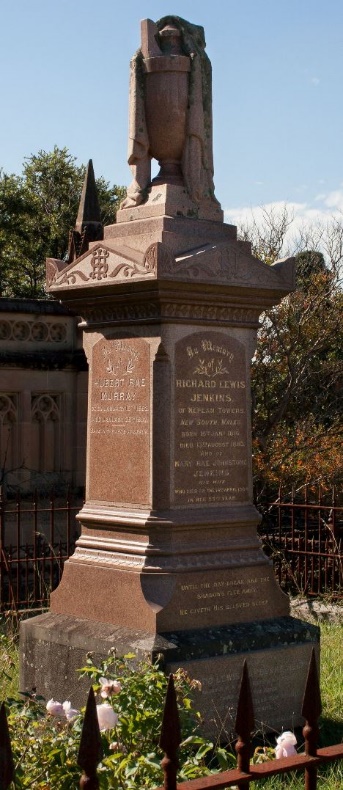
Godfrey Blake Jenkins, his eldest son, of Orielton Peats Ferry Road, Hornsby filled out a form for the Roll of Honour of Australia at the Memorial War Museum. He typed that Major Richard Lewis Hay Blake Jenkins of 20th Battalion AIF was associated with Sydney and Hornsby district. He had been born at Nepean Towers, Douglas Park NSW and had died on 11th December 1915 at ‘Russel Top ANZAC Gallipoli’, age 49. Richard was a regular solider in ‘Australian and Imperial Forces (not A.I.F.)’ He attended ‘Kings School Parramatta’ and Sydney Grammar School. For previous military service he recorded ‘Manchester Regt, Sydney Scottish Rifles, N.S.W. Permanent Artillery (R.A.A.)’. He served ‘in South African War and has Kings & Queens Medals with Five Bars, 2nd in Command of 20th Battn A.I.F. 1914/5 Medal, General Service and Victory Medals. For other members who served Godfrey recorded, ‘Captain G.L.B. Concannon of the 2nd Battn Nephew of deceased (K.I.A.)’ and ‘Flight Commander B Ralfe R.A.G.A. and Australian Flying Corps (Nephew of deceased) (K.I.A.).’ For other references Godfrey listed his mother Blanche E. Jenkins and G.B. Jenkins (his brother) of Belmont or Orielton Peats Ferry Road Hornsby NSW.
An article in Reveille Volume 3 No 7 in page 30 on 31 March 1930 from Brigadier General John Lamrock reads ‘Poor Uther met his end on the 13th November. He was a wonderful chap, a keen, lovable soldier. He was with two other good soldiers – Majors Jenkins and Harcus. It happened when it was decided to evacuate Anzac, the new Brigade was ordered to go back to Mudros, and the 20th were instructed to take over on the night of 13th November, and on the morning of that date the Headquarters staff (Major R.C.H. Jenkins, A/C.O., Major R.F. Fitzgerald A/2nd-in Command; Captain C.H. Howard, Adjutant, and the two senior company commanders, Majors J.I. Harcus and G.A. Uther) started to go out to Russell (sic) Top to go over the details. When proceeding up Monash Gully sap, a couple of shells were fired at the party from a ‘75’ at Olive Grove, but, as the trench was deep, no harm was done. When the party reached the top, the sentry there said the gun was shelling the wide sap heavily, and a halt was called. After a wait of a few minutes the party set off again, and had barely gone a dozen yards when a shell burst right among it, killing Uther, Jenkins and Harcus, and only knocking down Fitzgerald and Howard.’
The Sydney Morning Herald of Tuesday 7 December 1943 on page 8 under ‘DEATHS’ had an entry ‘JENKINS.—December 6, 1943, at Belmont Hornsby, Emily Mary Gwendolen (Gwen), only daughter of the late Major R. L. H. B. Jenkins, and Mrs. Blanche Jenkins and sister of Major Godfrey and Major Evan Jenkins. (Private cremation. By request, no flowers.)’
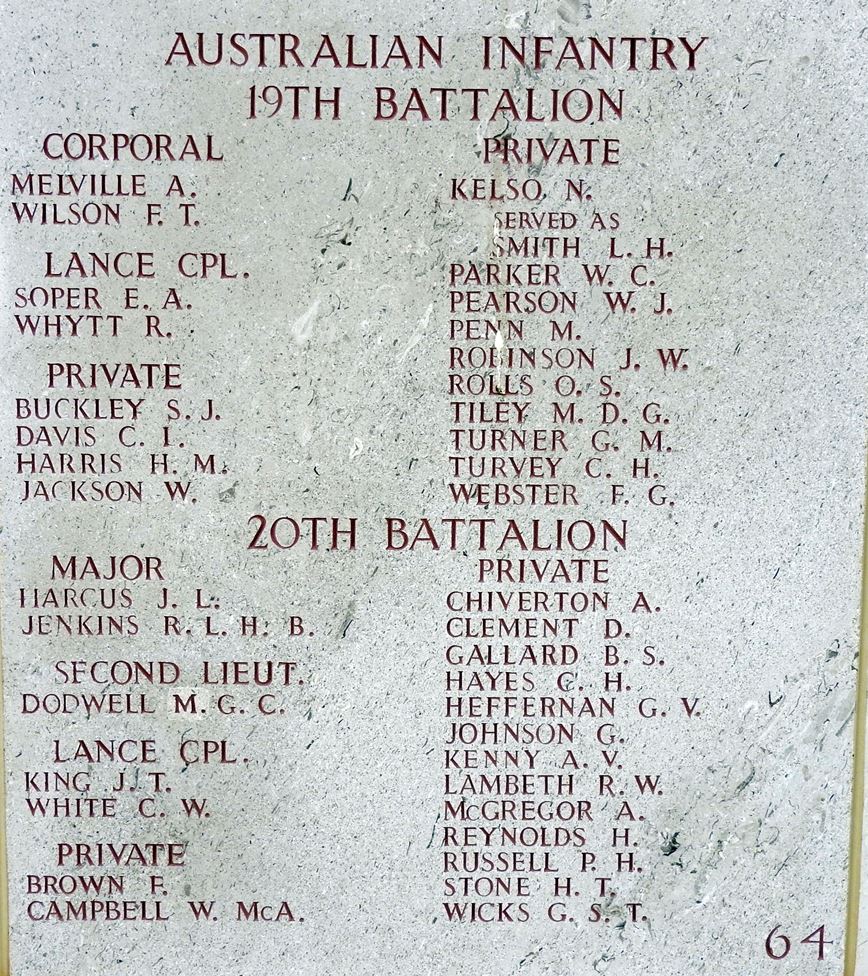
His name is recorded by the Commonwealth War Graves Commission in Index No. MR for the Lone Pine Memorial at Gallipoli in Part II – H to M as ‘JENKINS, Maj. Richard Lewis Hay Blake, 20th Bn. Killed in action 11th Dec., 1915. Age 49. Son of Richard Lewis Jenkins and Mary Rae Jenkins; husband of Blanche E. Jenkins (nee Johnstone), of Belmont, Hornsby, New South Wales. Served in the South African Campaign. 64.’ He is also listed in the book Anzac Memorial 1914-1918 in the pages of those who died on service.
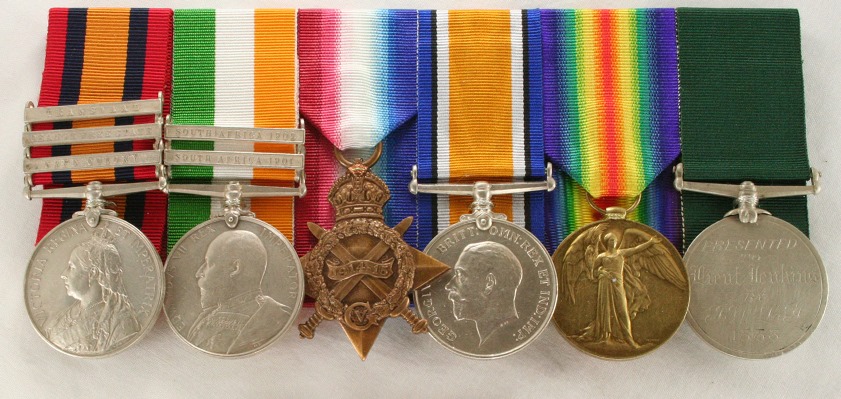
His medals are the Queens South Africa medal with clasps Cape Colony, Orange Free State and Transvaal, Kings South Africa medal with clasps South Africa 1901 and South Africa 1902, 1914-15 Star, British War and Victory medals. The last medal was presented to him by the Manchester Rifles in 1888.
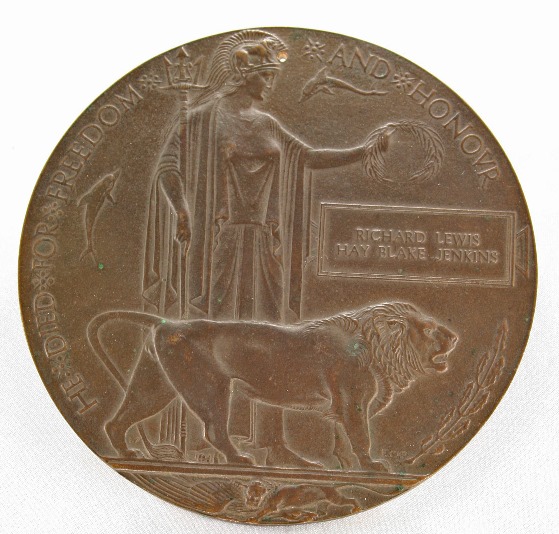
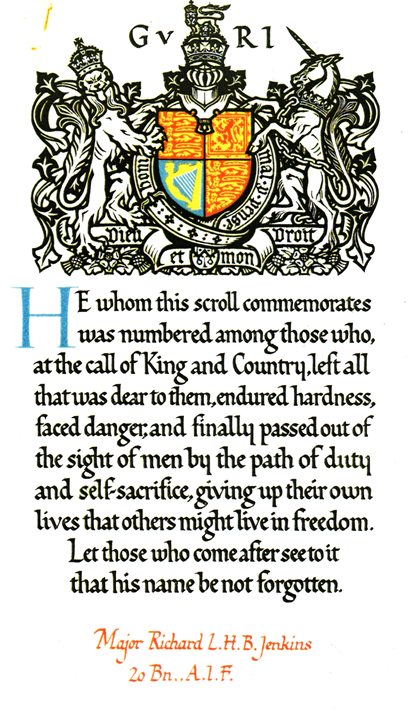
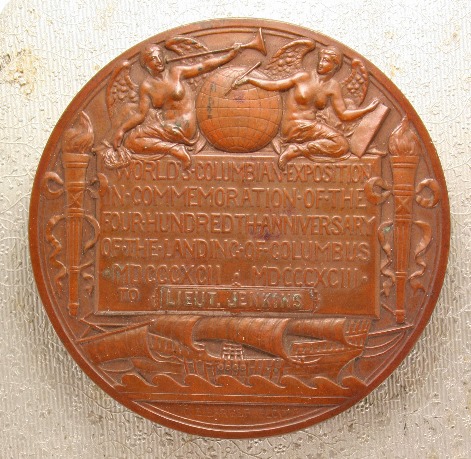
The World’s Columbian Exposition bronze medallion 1893, to Lieutenant Jenkins.
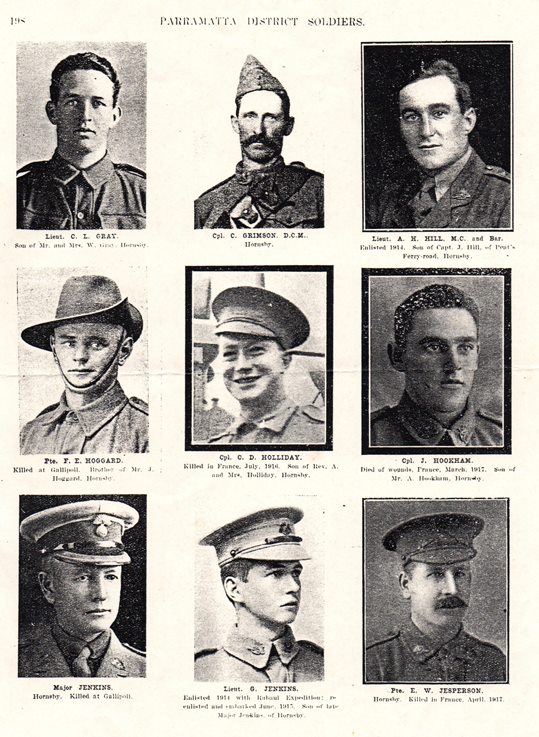
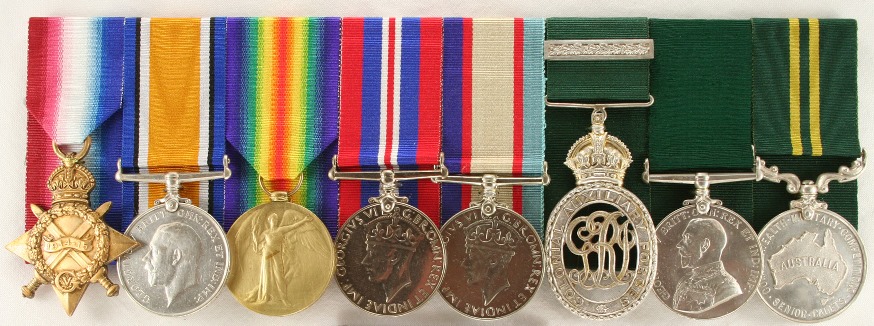
The medals for Godfrey Blake Jenkins are the 1914-15 Star, British War Medal, Victory Medal, 1939-45 War Medal, Australian Service Medal, Colonial Auxiliary Forced Decoration, Colonial Auxiliary Forces Long Service Medal and the Australia Commonwealth Military District Competition Senior Cadet medal.
ANZAC Biographies
On our website you will find the biographical details of ANZAC (as well as British) servicemen & women
whose medals or other memorabilia form part of the collection on display at the
Maryborough Military & Colonial Museum,
Maryborough, Queensland, Australia.